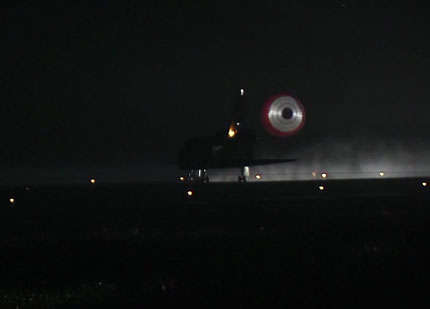Shuttle Endeavour By The Numbers: NASA's 19-Year-Old Space Baby

For more photos from Endeavour's final mission, visit:
Photos: Space Shuttle Endeavour's Final Mission - Part 2. (Image credit: NASA TV)
This story was updated June 1 at 3:25 a.m. ET.
The space shuttle Endeavour has capped a storied career with one final mission before it retires, leaving behind a 19-year legacy of flying in space.
Endeavour is NASA's youngest orbiter, built as a replacement for the shuttle Challenger, which was destroyed along with its crew in 1986.
The orbiter launched six astronauts into space on May 16 from NASA's Kennedy Space Center and returned to Earth in the wee hours of June 1. This final misison, STS-134, delivered a $2 billion particle detector called the Alpha Magnetic Spectrometer to the International Space Station, along with a set of backup supplies to outfit the station. [Photos: Shuttle Endeavour's Final Mission]
After this final voyage, Endeavour will be retired to the California Science Museum in Los Angeles for public display.
Here's a by-the-numbers look at Endeavour's lasting legacy in space:
122,883,151: The total miles Endeavour has traveled after its last voyage. [Video: Shuttle Endeavour Lands After Final Voyage]
Get the Space.com Newsletter
Breaking space news, the latest updates on rocket launches, skywatching events and more!
500,000: The number of spectators estimated to turn out to Florida's Space Coast to watch Endeavour's final launch.
6,154: The number of entries in a national student contest to name the space shuttle Endeavourwhen it was built. The name Endeavour honors the 17th century sailing ship HMB Endeavour, which was captained by British seaman James Cook on a famous voyage of exploration in the South Pacific.
17,400: The speed at which Endeavour traveled (in miles per hour) to remain in orbit. It's about Mach 25, or five times the speed of a bullet.
4,671: The number of orbits Endeavour made of Earth during all of its missions.
1992: The year Endeavour lifted off on its first flight. The orbiter carried seven astronauts to space on the STS-49 mission to rescue and repair a broken communications satellite.
299: The total number of days Endeavour has spent in space, counting those during this final flight STS-134.
133: The number of crew members Endeavour has carried to orbit, not including the six astronautsslated to ride the shuttle on the STS-134 mission.
25: The number of missions Endeavour will have flown by the time it is retired.
12: The number of times Endeavour will have visited the International Space Station before it is retired. The shuttle's trips to the orbiting laboratory include the very first U.S. space station mission, the STS-88 flight in December 1998 that launched the first American space station module, Unity.
4: The number of space shuttles that NASA built before Endeavour. Its predecessors include Columbia, Challenger, Discovery, and Atlantis. [The Most Memorable Space Shuttle Missions]
3.5: The number of years it took NASA to build Endeavour. Construction on the orbiter began in September 1987, and completed in April 1991.
1: The number of times Endeavour has visited the Hubble Telescope in orbit. The shuttle was used to launch the first Hubble servicing mission, STS-61 in December 1993, which famously corrected the observatory's faulty optics.
You can follow SPACE.com senior writer Clara Moskowitz on Twitter @ClaraMoskowitz.Visit SPACE.com for complete coverage of Endeavour's final mission STS-134 or follow us
Join our Space Forums to keep talking space on the latest missions, night sky and more! And if you have a news tip, correction or comment, let us know at: community@space.com.

Clara Moskowitz is a science and space writer who joined the Space.com team in 2008 and served as Assistant Managing Editor from 2011 to 2013. Clara has a bachelor's degree in astronomy and physics from Wesleyan University, and a graduate certificate in science writing from the University of California, Santa Cruz. She covers everything from astronomy to human spaceflight and once aced a NASTAR suborbital spaceflight training program for space missions. Clara is currently Associate Editor of Scientific American. To see her latest project is, follow Clara on Twitter.









